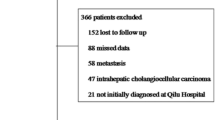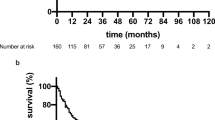Abstract
Background
The 6th edition TNM staging (TNM-6) for hepatocellular carcinoma (HCC) has been recommended. However, its superiority, in contrast to the previous 5th edition (TNM-5), has not been fully recognized. Besides, tumor differentiation was not included. The current study was designed to compare the value of these two staging systems and, more importantly, to elucidate whether Edmondson-Steiner grading, a well-acknowledged histological classification, is helpful in further discriminating different prognosis of HCC.
Methods
Prospectively collected clinicopathological and follow-up data of consecutive 171 patients with HCC undergoing curative hepatic resection (CHR) were reviewed retrospectively. The impacts of variables on survival were determined by univariate and multivariate statistical analyses.
Results
The differences of survival between stages of the TNM-6 and TNM-5 were almost significant, except for disease-free survival for TNM-5. Moreover, TNM-6 might be a more powerful prognostic predictor compared with TNM-5, although their impacts on survival were all not independent, unlike Edmondson-Steiner grading. For patients with each stage of TNM-6, Edmondson-Steiner grade was the sole significant variable in both univariate and multivariate analyses. Finally, a novel scoring criteria (prognostic scoring for CHR, PSCHR) integrating Edmondson-Steiner grading and TNM-6 was attempted and statistically shown to be of independent significance and stronger predicting value for prognosis of curatively resected HCC.
Conclusion
TNM-6 revealed to be more significantly prognostic than TNM-5 in patients with HCC after curative hepatic resection. Edmondson-Steiner grading could raise the predictive efficiency of TNM-6 for postresectional survival of patients with HCC. Therefore, PSCHR containing Edmondson-Steiner grading was preliminarily proposed.


Similar content being viewed by others
References
Parkin DM, Pisani P, Ferlay J (1993) Estimates of the worldwide incidence of eighteen major cancers in 1985. Int J Cancer 54:594–606
Pisani P, Parkin DM, Bray F, Ferlay J (1999) Estimates of the worldwide mortality from 25 cancers in 1990. Int J Cancer 83:18–29
Parkin DM, Bray F, Ferlay J, Pisani P (2005) Global cancer statistics, 2002. CA Cancer J Clin 55:74–108
Primack A, Vogel CL, Kyalwazi SK, Ziegler JL, Simon R, Anthony PP (1975) A staging system for hepatocellular carcinoma: prognostic factors in Ugandan patients. Cancer 35:1357–1364
Okuda K, Ohtsuki T, Obata H et al (1985) Natural history of hepatocellular carcinoma and prognosis in relation to treatment. Study of 850 patients. Cancer 56:918–928
The Cancer of the Liver Italian Program (CLIP) Investigators (1998) A new prognostic system for hepatocellular carcinoma: a retrospective study of 435 patients. Hepatology 28:751–755
Llovet JM, Bru C, Bruix J (1999) Prognosis of hepatocellular carcinoma: the BCLC staging classification. Semin Liver Dis 19:329–337
Leung TW, Tang AM, Zee B et al (2002) Construction of the Chinese University Prognostic Index for hepatocellular carcinoma and comparison with the TNM staging system, the Okuda staging system, and the Cancer of the Liver Italian Program staging system: a study based on 926 patients. Cancer 94:1760–1769
Kudo M, Chung H, Osaki Y (2003) Prognostic staging system for hepatocellular carcinoma (CLIP score): its value and limitations, and a proposal for a new staging system, the Japan integrated staging score (JIS score). J Gastroenterol 38:207–215
Fleming I, Cooper J, Hensen D (1997) Liver AJCC cancer staging manual. 5th edn. Lippincott-Raven, Philadelphia
Huang YH, Chen CH, Chang TT et al (2005) Evaluation of predictive value of CLIP, Okuda, TNM and JIS staging systems for hepatocellular carcinoma patients undergoing surgery. J Gastroenterol Hepatol 20:765–771
Farinati F, Rinaldi M, Gianni S, Naccarato R (2000) How should patients with hepatocellular carcinoma be staged? Validation of a new prognostic system. Cancer 89:2266–2273
Anonymous (2002) Liver including intrahepatic bile ducts. In: Greene F, Page D, Fleming I (eds) American Joint Committee on cancer staging manual. 6th edn. Springer, New York, pp 131–144
Vauthey JN, Lauwers GY, Esnaola NF et al (2002) Simplified staging for hepatocellular carcinoma. J Clin Oncol 20:1527–1536
Lei HJ, Chau GY, Lui WY et al (2006) Prognostic value and clinical relevance of the 6th Edition 2002 American Joint Committee on Cancer staging system in patients with resectable hepatocellular carcinoma. J Am Coll Surg 203:426–435
Ramacciato G, Mercantini P, Cautero N et al (2005) Prognostic evaluation of the new American Joint Committee on Cancer/International Union Against Cancer staging system for hepatocellular carcinoma: analysis of 112 cirrhotic patients resected for hepatocellular carcinoma. Ann Surg Oncol 12:289–297
Varotti G, Ramacciato G, Ercolani G et al (2005) Comparison between the fifth and sixth editions of the AJCC/UICC TNM staging systems for hepatocellular carcinoma: multicentric study on 393 cirrhotic resected patients. Eur J Surg Oncol 31:760–767
Kee KM, Wang JH, Lee CM et al (2007) Validation of clinical AJCC/UICC TNM staging system for hepatocellular carcinoma: analysis of 5,613 cases from a medical center in southern Taiwan. Int J Cancer 120:2650–2655
Minagawa M, Ikai I, Matsuyama Y, Yamaoka Y, Makuuchi M (2007) Staging of hepatocellular carcinoma: assessment of the Japanese TNM and AJCC/UICC TNM systems in a cohort of 13,772 patients in Japan. Ann Surg 245:909–922
Qiang L, Huikai L, Butt K, Wang PP, Hao X (2006) Factors associated with disease survival after surgical resection in Chinese patients with hepatocellular carcinoma. World J Surg 30:439–445
Shah SA, Greig PD, Gallinger S et al (2006) Factors associated with early recurrence after resection for hepatocellular carcinoma and outcomes. J Am Coll Surg 202:275–283
Martins A, Cortez-Pinto H, Marques-Vidal P et al (2006) Treatment and prognostic factors in patients with hepatocellular carcinoma. Liver Int 26:680–687
Tanigawa N, Lu C, Mitsui T, Miura S (1997) Quantitation of sinusoid-like vessels in hepatocellular carcinoma: its clinical and prognostic significance. Hepatology 26:1216–1223
Horigome H, Nomura T, Saso K, Itoh M (1999) Standards for selecting percutaneous ethanol injection therapy or percutaneous microwave coagulation therapy for solitary small hepatocellular carcinoma: consideration of local recurrence. Am J Gastroenterol 94:1914–1917
Tamura S, Kato T, Berho M et al (2001) Impact of histological grade of hepatocellular carcinoma on the outcome of liver transplantation. Arch Surg 136:25–30
Si MS, Amersi F, Golish SR et al (2003) Prevalence of metastases in hepatocellular carcinoma: risk factors and impact on survival. Am Surg 69:879–885
Roayaie S, Schwartz JD, Sung MW et al (2004) Recurrence of hepatocellular carcinoma after liver transplant: patterns and prognosis. Liver Transpl 10:534–540
Lin SM, Lin CJ, Lin CC, Hsu CW, Chen YC (2004) Radiofrequency ablation improves prognosis compared with ethanol injection for hepatocellular carcinoma ≤4 cm. Gastroenterology 127:1714–1723
Kubo S, Tanaka H, Shuto T et al (2005) Clinicopathologic features and outcome after liver resection for hepatocellular carcinoma in patients with concurrent versus previous chronic hepatitis B. Surg Today 35:216–222
Lin SM, Lin CJ, Lin CC, Hsu CW, Chen YC (2005) Randomised controlled trial comparing percutaneous radiofrequency thermal ablation, percutaneous ethanol injection, and percutaneous acetic acid injection to treat hepatocellular carcinoma of 3 cm or less. Gut 54:1151–1156
Qian YB, Zhang JB, Wu WZ et al (2006) P48 is a predictive marker for outcome of postoperative interferon-alpha treatment in patients with hepatitis B virus infection-related hepatocellular carcinoma. Cancer 107:1562–1569
Zhou L, Rui JA, Wang SB et al (2003) Multi-modal serial therapy for primary liver cancer in senile patients: a report of 153 cases. Zhonghua Zhong Liu Za Zhi 25:404–406
Qu Q, Rui JA, Wang SB et al (2006) Comparison of different clinical staging systems for hepatocellular carcinoma. Zhonghua Zhong Liu Za Zhi 28:155–158
Zhou L, Rui JA, Wang SB et al (2006) Clinicopathological features, post-surgical survival and prognostic indicators of elderly patients with hepatocellular carcinoma. Eur J Surg Oncol 32:767–772
Zhou L, Rui JA, Wang SB et al (2007) Factors predictive for long-term survival of male patients with hepatocellular carcinoma after curative resection. J Surg Oncol 95:298–303
Zhou L, Rui JA, Wang SB et al (2007) Outcomes and prognostic factors of cirrhotic patients with hepatocellular carcinoma after radical major hepatectomy. World J Surg 31:1782–1787
Edmondson HA, Steiner PE (1954) Primary carcinoma of the liver: a study of 100 cases among 48,900 necropsies. Cancer 7:462–503
Suehiro T, Matsumata T, Itasaka H, Yamamoto K, Kawahara N, Sugimachi K (1995) Clinicopathologic features and prognosis of resected hepatocellular carcinomas of varied sizes with special reference to proliferating cell nuclear antigen. Cancer 76:399–405
Chen TW, Chu CM, Yu JC et al (2007) Comparison of clinical staging systems in predicting survival of hepatocellular carcinoma patients receiving major or minor hepatectomy. Eur J Surg Oncol 33:480–487
Zavaglia C, De Carlis L, Alberti AB et al (2005) Predictors of long-term survival after liver transplantation for hepatocellular carcinoma. Am J Gastroenterol 100:2708–2716
Wada H, Nagano H, Yamamoto H et al (2006) Expression pattern of angiogenic factors and prognosis after hepatic resection in hepatocellular carcinoma: importance of angiopoietin-2 and hypoxia-induced factor-1 alpha. Liver Int 26:414–423
Oishi K, Itamoto T, Amano H et al (2007) Clinicopathologic features of poorly differentiated hepatocellular carcinoma. J Surg Oncol 95:311–316
Le Treut YP, Hardwigsen J, Ananian P et al (2006) Resection of hepatocellular carcinoma with tumor thrombus in the major vasculature. A European case-control series. J Gastrointest Surg 10:855–862
Acknowledgements
The authors thank all of the colleagues of the Department of Pathology, Peking Union Medical College Hospital, who took part in determination of Edmondson-Steiner grading.
Author information
Authors and Affiliations
Corresponding author
Rights and permissions
About this article
Cite this article
Zhou, L., Rui, JA., Ye, DX. et al. Edmondson-Steiner Grading Increases the Predictive Efficiency of TNM Staging for Long-term Survival of Patients with Hepatocellular Carcinoma After Curative Resection. World J Surg 32, 1748–1756 (2008). https://doi.org/10.1007/s00268-008-9615-8
Published:
Issue Date:
DOI: https://doi.org/10.1007/s00268-008-9615-8




